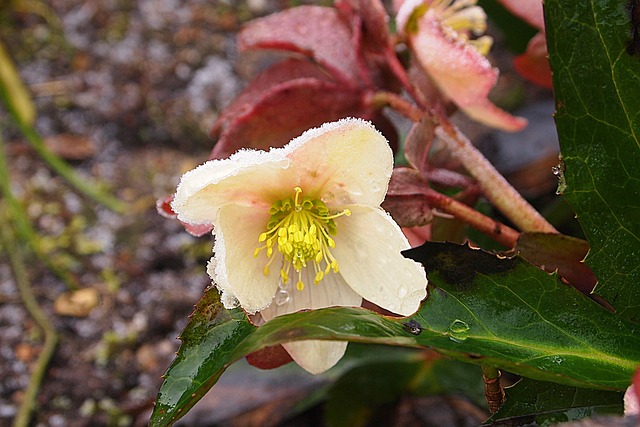Frozen pipes are a common winter issue caused by water expanding as it freezes within pipes. To prevent them, insulate vulnerable areas like outdoor plumbing and use heating tape. Keep faucets slightly open to prevent freezing, and regularly inspect pipes for damage or gaps in insulation. Maintaining a warm indoor environment and using these winter plumbing tips safeguard against frozen pipes, mold growth, and costly repairs.
In frigid winters, frozen pipes pose a significant threat to home and property owners alike. Understanding the causes and consequences of frozen pipes is the first step towards effective prevention. This guide offers comprehensive solutions, from robust pipe insulation techniques to innovative heating tape applications. We also delve into winter-specific strategies for addressing faucet dripping and protecting outdoor plumbing, ensuring you’re equipped to safeguard your space from cold-weather plagues.
- Understanding Frozen Pipes: Causes and Consequences
- Effective Pipe Insulation Techniques for Winter
- Heating Tape: A Direct Solution to Prevent Freezing
- Addressing Faucet Dripping: Winter-Specific Strategies
- Outdoor Plumbing Management: Protecting Against Extreme Cold
Understanding Frozen Pipes: Causes and Consequences

Frozen pipes are a common winter woe, caused primarily by water within pipes freezing and expanding. This expansion puts immense pressure on pipes, which can lead to bursts and significant damage. The consequences include not only water damage but also potential mold growth and costly repairs. Understanding these causes is key to implementing effective frozen pipes prevention strategies.
Pipe insulation, a crucial winter plumbing tip, helps maintain constant temperature in pipes, preventing freezing. Insulating outdoor plumbing and exposed pipes with heating tape or special pipe insulation materials is essential, especially in regions with cold winters. Additionally, simple measures like keeping faucets slightly open to create a drip can help keep water moving, reducing the risk of freezing.
Effective Pipe Insulation Techniques for Winter

To prevent frozen pipes during winter, effective pipe insulation is crucial. Start by identifying vulnerable areas such as outdoor plumbing and pipes exposed to extreme temperature fluctuations. Insulate these with high-quality pipe insulation materials like foam or fiber glass to create a protective barrier against cold weather. For existing pipes, wrap heating tape around them for an instant fix, ensuring the tape is rated for indoor/outdoor use and properly secured.
Regular maintenance can further mitigate risks. Check for any signs of damage or gaps in insulation and repair promptly. If you notice a faint dripping from faucets, don’t ignore it—it could indicate a leaking pipe, which needs immediate attention to prevent freezing. By implementing these winter plumbing tips, you’ll safeguard your indoor temperature above freezing and avoid costly frozen pipes prevention measures.
Heating Tape: A Direct Solution to Prevent Freezing

Maintaining a warm indoor environment is crucial, especially during chilly winters, to prevent frozen pipes and ensure year-round plumbing functionality. One effective solution for direct frozen pipe prevention is using heating tape. This innovative product is designed to wrap around pipes, providing efficient heat to keep them from freezing. Heating tape is a popular choice among winter plumbing tips enthusiasts due to its simplicity and effectiveness.
When installing outdoor plumbing or adding insulation to pipes, consider incorporating heating tape as an extra layer of protection. It’s particularly useful in areas prone to extreme cold, preventing pipe bursts and the costly repairs that often follow. By keeping water within a safe temperature range, you can say goodbye to unsightly frozen pipes and the hassle of emergency plumbing situations.
Addressing Faucet Dripping: Winter-Specific Strategies

Winter can be a challenging season for your home’s plumbing system, especially when it comes to preventing frozen pipes. One common issue that many homeowners face is faucet dripping, which can lead to significant water waste and even pipe damage if left unattended. During freezing temperatures, these drips can transform into ice, causing pipes to burst and leading to costly repairs.
Addressing this problem requires a multi-pronged approach, especially for outdoor plumbing and those living in regions with harsh winters. One effective strategy is to invest in quality pipe insulation, which acts as an extra layer of protection against cold temperatures. Additionally, applying heating tape around pipes can help maintain a consistent, above-freezing temperature. For faucets that drip frequently, consider turning off the water supply during colder months and using winter plumbing tips like sealing gaps or using insulating covers to prevent cold air from reaching the pipes.
Outdoor Plumbing Management: Protecting Against Extreme Cold

To prevent frozen pipes during extreme cold weather, proper management of outdoor plumbing is crucial. Start by insulating exposed pipes with pipe insulation to minimize heat loss. This simple step can go a long way in protecting against freezing temperatures and subsequent damage caused by burst pipes. Install heating tape on sensitive areas like faucet lines and water supply hoses to keep them above freezing point.
Regularly check for any signs of leaks or drips from outdoor faucets. Even a small drip can lead to significant ice formation over time, so addressing these issues promptly is essential. Additionally, consider draining and insulating garden hoses when not in use. These winter plumbing tips will help ensure your outdoor plumbing system remains functional during the cold season, avoiding costly repairs due to frozen pipes.
